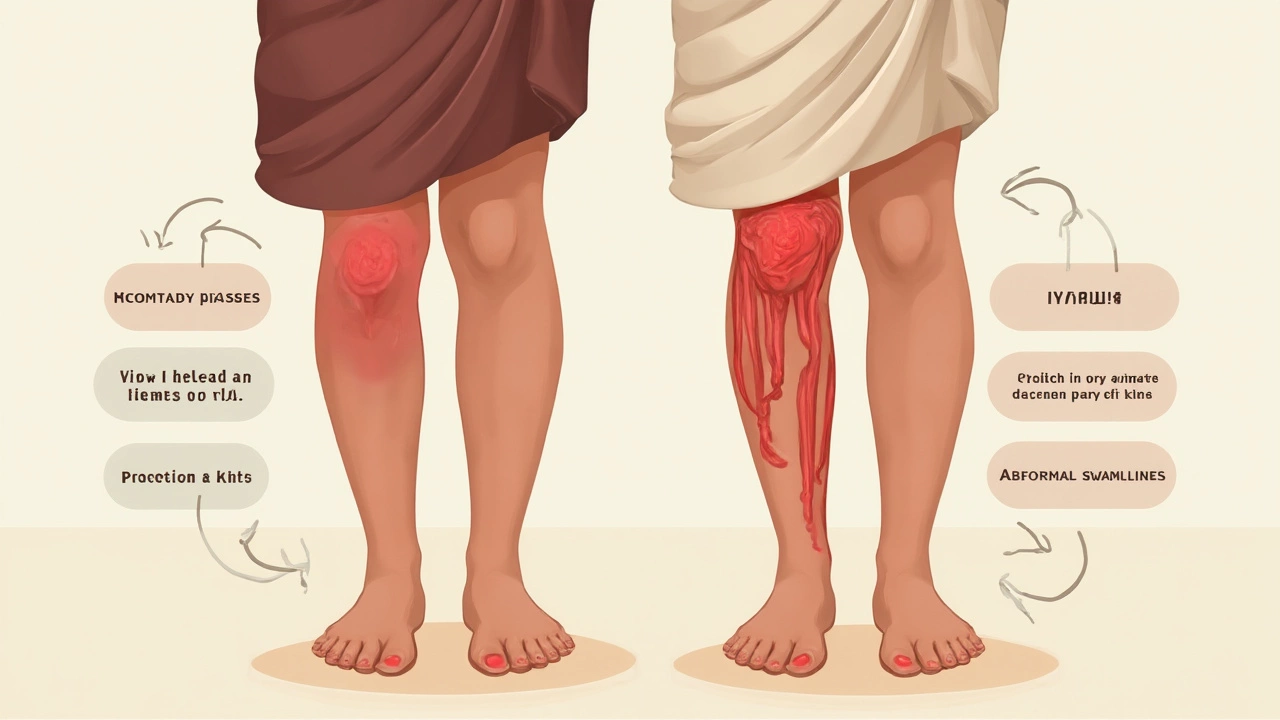After a total knee replacement, it's normal to feel sore, stiff, or even a bit anxious. But not every pain or twinge is just part of getting better. Some symptoms can actually be your body waving a giant red flag, warning you something’s not right.
Knowing which warning signs to watch out for can keep you ahead of nasty problems. Think of these red flags as true need-to-know stuff—ignore them and you could be looking at more surgery, a long hospital stay, or even bigger health risks.
If you’re home recovering and start feeling really unwell or suddenly see obvious changes in your knee, don’t just wait and hope for the best. Some problems move fast and doing nothing can make things a whole lot worse. It’s always smarter to catch a problem early, rather than wish you had later on.
- When is pain not normal?
- Swelling versus infection: Telling the difference
- Warning signs you shouldn’t wait on
- Uncommon but dangerous problems
- Smart ways to keep out of trouble
When is pain not normal?
Some pain is just the body working through healing, but certain types of pain—especially after a knee replacement—can point to big trouble. So, what actually sets off alarm bells?
Pain should slowly get better as you recover. It's normal for the first week or so to be rough, but after that, you should notice gradual improvement. If pain suddenly gets worse, or just never seems to let up, that’s not normal. Sharp, stabbing pain that keeps you up at night or stops you from moving your leg needs a look from your doctor.
Here are signs your pain might be a problem:
- Pain getting worse instead of easing up over days or weeks
- Thunderbolt pain with movement (not just a mild ache or discomfort)
- Pain that spreads to your calf, thigh, or even groin
- Rest pain that wakes you up or won’t let you sleep
One major red flag is pain paired with swelling and heat in the knee, especially if your whole leg swells up. This combo could mean infection or a blood clot, both of which can spin out of control fast.
Doctors often use a pain scale to track your progress. In the hospital, you probably rated pain from 0 to 10. Here’s a quick way to see if your pain score is a warning sign:
| Pain Score (0-10) | What It Probably Means |
|---|---|
| 0-3 | Mild, expected in most recoveries |
| 4-6 | Some soreness, check if it's improving |
| 7-10 | Unexpected—contact your team |
Bottom line: If pain just isn’t following the usual pattern, or if it suddenly gets worse after starting to get better, treat it as a red flag after knee replacement. Call your doctor without waiting. Ignoring serious pain can delay proper treatment or even put your new knee replacement at risk.
Swelling versus infection: Telling the difference
Swelling is basically the name of the game after a knee replacement. Your knee’s been cut open, re-shaped, and put back together, so some puffiness is totally expected. Most folks see swelling peak by day 3 and then start to slowly chill out over the next two to three weeks. But here’s where things get tricky—how do you know when normal swelling flips into a sign of complications or even infection?
Healthy swelling should:
- Stay mostly around the knee or leg
- Go down when you elevate your leg or use ice
- Not come with lots of heat, redness, or extreme pain
But infection tells a different story. Here’s what sets it apart:
- Swelling gets worse instead of better
- Red, angry skin around your incision
- Incision oozes pus or looks extra wet
- The knee feels hotter than elsewhere on your leg
- Fever over 101°F (38.3°C), chills, or bad sweats
- Sharp, throbbing pain that doesn’t match your movement
If you spot any two or more of those signs, don’t try and tough it out. Infections after knee replacement surgery can turn serious fast. According to the American Academy of Orthopedic Surgeons, infection happens in about 1-2% of cases, but it’s the number-one reason people sometimes need another surgery.
| Normal Swelling | Possible Infection |
|---|---|
| Mild or moderate, gets better with rest | Worsening or suddenly severe swelling |
| No fever | Fever over 101°F / 38.3°C |
| No pus, incision looks dry | Oozing or pus from incision |
| Normal skin color | Red, hot, extra tender skin |
Bottom line: If swelling just won’t quit or you see signs of infection, call your doctor. Trust your gut—you live in your body, you know when something isn’t right with your knee replacement.

Warning signs you shouldn’t wait on
After a knee replacement, you expect a certain amount of swelling or soreness, but there are some clear signals that should send you straight to your doctor or even the ER. These aren’t just minor bumps in the road—they’re serious red flags that something could be really wrong with your new knee.
- Fever over 101°F (38.3°C): If your temperature jumps up and you feel hot and shivery, this could mean an infection. Even a low-grade fever that keeps coming back is a reason to call your doctor.
- Red, hot, or oozing knee: Major redness, warmth that gets worse instead of better, or any yellow/green fluid leaking out of your wound aren’t normal. These are classic signs of an infection around your new joint.
- Sudden or severe pain that won’t quit: Achiness is normal, but if you experience intense, stabbing, or increasing pain that painkillers can’t touch, that’s a big warning sign.
- Shortness of breath or chest pain: Not knee pain, but after surgery, there’s a small risk of a blood clot traveling to your lungs. If you suddenly can’t catch your breath or feel tightness in your chest, call emergency services right away.
- Hard swelling in your calf: If you notice sudden swelling, redness, or warmth at the back of your lower leg, you could have a blood clot (deep vein thrombosis). Don’t ignore it—this can turn dangerous fast.
- Knee locked or can’t move: If your knee suddenly feels stuck and you literally can’t bend or straighten it, something is wrong inside. You’ll want this checked as soon as possible.
- Foul smell: Drainage that smells bad means bacteria have moved in. Normal healing doesn’t stink.
Here’s a quick look at some of those red flag signs and how often they actually happen, based on hospital data:
| Warning Sign | How Often? |
|---|---|
| Infection | 1–2% |
| Blood clot (DVT/PE) | About 1% |
| Severe stiffness or locked knee | Less than 5% |
If you run into any of these symptoms after your knee replacement, don’t gamble with your health. Call your healthcare team right away or get to the emergency room. Catching these problems early is the best way to save your new joint—and sometimes even your life.
Uncommon but dangerous problems
Most people fly through knee replacement recovery with little more than some aches and swelling, but rare problems can throw a serious wrench into your plans. Even though they're not common, you should know exactly what to look for so you don't get blindsided.
One big risk that doesn't get enough talk is a blood clot, or DVT (deep vein thrombosis). After surgery like this, your leg isn’t moving as much, and that gives blood a chance to pool and clot. A clot in your leg can be bad, but if it breaks off and travels to your lungs (pulmonary embolism), that’s a true emergency. Watch out for these warning signs:
- Sudden swelling in the calf or behind the knee that's not going down
- Pain in your calf that gets worse when you flex your foot or walk
- Redness or warmth in your leg
- Shortness of breath, chest pain, or coughing up blood (call 911 right away if you get these!)
Another uncommon but dangerous problem is nerve injury. While really rare—less than 1% according to actual hospital stats—damaged nerves can lead to numbness, tingling, or even the inability to move your foot up toward your shin (called “foot drop”). If you suddenly can’t move part of your foot or toes, don’t shrug it off.
Joint instability is another curveball. Sometimes, the new joint just doesn’t stay put. You might feel your knee giving way unexpectedly or even lock up. While most surgeons double-check alignment during your knee replacement, these issues still creep up for a few.
Here's a quick look at some numbers around rare but serious problems after knee replacement:
| Problem | How Often (per 100 surgeries) |
|---|---|
| Blood clot (DVT/PE) | 1 - 2 |
| Nerve injury | <1 |
| Joint instability | 2 - 3 |
While the odds aren’t sky-high, these problems call for quick action. The takeaway? Trust your gut. If something seems off or different from your surgeon’s warnings about normal recovery, make the call. Better to hear it’s "no big deal" than to risk a big complication.

Smart ways to keep out of trouble
If you've just had a knee replacement, a big part of your recovery is about staying alert and following advice. But it isn’t rocket science—most of it comes down to some everyday habits and paying attention to your body.
First off, stick to your physical therapy plan. Skipping exercises or pushing yourself too hard both invite issues. Your physio isn't just inventing random stretches—these moves help your new knee work smoothly and keep dangerous scar tissue from building up.
- Stick to pain meds as your doctor prescribes. Too little and you won’t do your exercises; too much and you’ll mask real warning signs.
- Don’t ditch your follow-ups. Surgeons and nurses spot problems you might not notice, sometimes even before you feel off.
- Keep your wound clean and dry, and change dressings as told. A little redness is normal, but funky smells or pus? Time to call your doctor.
- Keep moving but listen to your knee. Long sits can cause a blood clot, but overdoing it can send you backwards.
Here’s a handy table showing what’s normal and what’s not after a knee replacement:
| What’s Normal | Red Flag |
|---|---|
| Mild swelling, getting a bit less after a week | Severe swelling or swelling that suddenly gets worse |
| Soreness or bruising around the knee | Severe, constant pain that medicine doesn’t help |
| Some mild warmth by the knee | Hot, red, or oozing wound |
Don't forget about your daily check. It can be as simple as looking at your wound, moving your leg, and noting how you feel. If you notice suddenly feeling out of breath, chest pain, or your operated leg changing color, get help fast—these aren’t just "bad days." Research shows most hospital readmissions after total knee replacement are actually related to infections or blood clots within the first month. Spotting issues early is the name of the game.
Play it safe, keep a list of emergency contacts on your fridge, and set phone reminders for medication and appointments. These little steps make a massive difference. Bottom line? Trust your gut—if something feels wrong, your doctor wants to know, so don’t hold back or second guess yourself.






